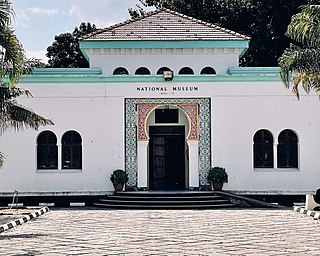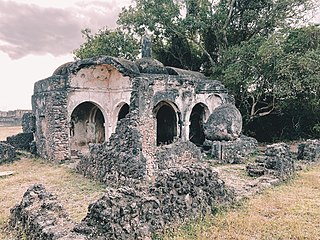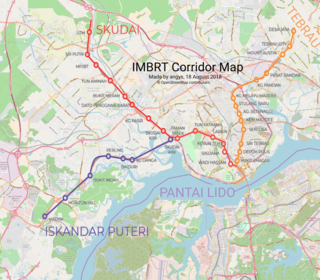
Dar es Salaam or commonly known as Dar, is the largest city and financial hub of Tanzania. It is also the capital of Dar es Salaam Region. With a population of over six million people, Dar is the largest city in East Africa and the seventh-largest in Africa. Located on the Swahili coast, Dar es Salaam is an important economic centre and is one of the fastest-growing cities in the world.
Transport in Tanzania includes road, rail, air and maritime networks. The road network is 86,472 kilometres (53,731 mi) long, of which 12,786 kilometres (7,945 mi) is classified as trunk road and 21,105 kilometres (13,114 mi) as regional road. The rail network consists of 3,682 kilometres (2,288 mi) of track. Commuter rail service is in Dar es Salaam only. There are 28 airports, with Julius Nyerere International being the largest and the busiest. Ferries connect Mainland Tanzania with the islands of Zanzibar. Several other ferries are active on the countries' rivers and lakes.
Dart or DART may refer to:

Bus rapid transit (BRT), also called a busway or transitway, is a bus-based public transport system designed to have much more capacity, reliability and other quality features than a conventional bus system. Typically, a BRT system includes roadways that are dedicated to buses, and gives priority to buses at intersections where buses may interact with other traffic; alongside design features to reduce delays caused by passengers boarding or leaving buses, or paying fares. BRT aims to combine the capacity and speed of a light rail or metro system with the flexibility, lower cost and simplicity of a bus system.

TransMilenio is a bus rapid transit (BRT) system that serves Bogotá, the capital of Colombia, and Soacha. The system opened to the public in December 2000, covering Caracas Avenue and 80 street. Other lines were added gradually over the next several years, and as of 2022, 12 lines totalling 114.4 km (71 mi) run throughout the city. It is part of the city's Integrated Public Transport System, along with the urban, complementary and special bus services operating on neighbourhoods and main streets.
STRABAG SE is an Austrian construction company based in Spittal an der Drau, Austria, with its headquarters in Vienna. It is the largest construction company in Austria and one of the largest construction companies in Europe. The company is active in its home markets Austria and Germany and in all countries of Central, Eastern and South-East Europe, in selected markets in Western Europe, on the Arabian Peninsula, as well as in Canada, Chile, China and India. In these markets STRABAG has subsidiaries or operates on a project-basis.

Kivukoni is an administrative ward located in Ilala District, Dar es Salaam Region of Tanzania. Kivikoni's name come from the Swahili word meaning "a crossing place". The ward is bordered by Upanga East ward to the west, Kisutu ward to the southwest, and Kigamboni ward across the Kivukoni channel. The ward covers an area of 2.387 km2 (0.922 sq mi). Kivukoni ward is one of the most important wards in the country, as it is home to the Ikulu, which is the home of the president of Tanzania. Kivukoni ward is also home to the National Museum of Tanzania. According to the 2012 census, the ward had a total population of 6,742.

Kilwa Masoko or Masoko is an administrative ward in Kilwa District of Lindi Region in Tanzania. The ward covers an area of 200 km2 (77 sq mi), and has an average elevation of 11 m (36 ft). The ward is also the capital of Kilwa District. According to the 2012 census, the ward has a total population of 13,601.

The Iskandar Malaysia Bus Rapid Transit (IMBRT) is a proposed bus rapid transit system to be built in and around Iskandar Malaysia, Johor, Malaysia. It will consist of trunk, direct, and feeder bus rapid transit corridors.

Tanzania Ports Authority (TPA) is a parastatal public corporation acting under the aegis of the Ministry of Infrastructure Development, that has the responsibility "to manage and operate" the ocean ports and lake ports of the country of Tanzania. The Tanzania Ports Authrorty headquarters are located in Kurasini Dar es Salaam. It is a member of the Port Management Association of Eastern and Southern Africa.

MyCiti is a bus rapid transit service with feeders, which forms part of a greater Integrated Public Transport driven economic development strategy of the City of Cape Town Municipality (CoCT) in South Africa. The service is being rolled out across the Cape Metropole, and provides a significantly enhanced public transport system in about 10% of the City. The service commenced in 2010 with Phase 1, which features buses running north to south along the west coastline of the City.

The first bus rapid transit in Brazil (BRT) was built in 1974 in the city of Curitiba by the then mayor, architect Jaime Lerner, and became the second BRT in the world. The goal of the system is to provide high quality rail transit service to customers and at a comparable cost to that of a bus transit. Curitiba's success inspired the implementation of similar plans in more than 100 cities around the world, including the Brazilian cities of São Paulo, Rio de Janeiro, Belo Horizonte, Porto Alegre, Manaus, Goiânia, Aracaju, Salvador, Recife, and Brasília.

The Cebu Bus Rapid Transit System is a planned mass transit system for Cebu City located within the greater Cebu Metropolitan Area. It is expected to become the first operational bus rapid transit project in the Philippines. Only one line has been planned in detail so far, but scheme developers note the potential to develop a larger network comprising the adjacent cities Lapu-Lapu, Mandaue and Talisay. Leadership in both Lapu-Lapu and Mandaue have shown interest in the network. This will be constructed at the end or last quarter of 2017 and the first route could be operational by the end of 2019.

Nyerere Bridge is a 680-meter-long bridge in Tanzania that connects the Dar es Salaam ward of Kurasini from the east to the west of Kigamboni district across the Kurasini estuary. Construction work began in February 2012 and completed in April 2016. The completion of the bridge has offered an alternative transport link to the new district of Kigamboni. Previously, the Kivukoni ferry provided a quick transport link between south east of the Dar es Salaam Central Business District specifically from south east of Kivukoni to north west of Kigamboni. The bridge has six lanes and two pedestrians/cyclists lanes with width of 2.5 meters. Construction of 2.5 km approach roads were completed with 1 km on the Kurasini side and 1.5 km on the Kigamboni side. The road joins the Nelson Mandela expressway through elevated free interchange to separate traffic approaching and leaving the junction. There is a toll plaza for controlling and charging of vehicles passing through the bridge. A total of 14 controlled lanes are going to be in this area.

The Dar es Salaam commuter rail, informally known as Treni ya Mwakyembe, is an urban and suburban commuter rail network serving the Tanzanian commercial city of Dar es Salaam. It is one of the two initiatives taken by the government to ease travel within the congested city; the other being the Dar es Salaam bus rapid transit system. Services are provided by the Tanzania-Zambia Railway Authority (TAZARA) and Tanzania Railways Limited (TRL).

The Dar Rapid Transit Agency (DART) is an executive agency of Tanzania with the mandate to establish and operate a bus rapid transit system in Dar es Salaam.

Rainbow BRTS is a bus rapid transit system in the city of Pune. The system is operated by the Pune Mahanagar Parivahan Mahamandal Limited (PMPML). The infrastructure has been developed by the Pune Municipal Corporation & Pimpri Chinchwad Municipal Corporation, Pune. The project currently envisages 113 km of dedicated bus corridors along with buses, bus stations, terminals and intelligent transit management system.

Zhengzhou Bus Rapid Transit is a bus rapid transit system in Zhengzhou, the capital of Henan Province in the People's Republic of China. The system has 5 main trunk routes with dedicated bus lanes along with a number of feeder routes that run for a portion of the corridor and serves other areas.
TransPeshawar or Peshawar BRT is a bus rapid transit system in Peshawar, capital of Pakistan's Khyber Pakhtunkhwa (KP) province. TransPeshawar BRT system consists of two parts: the first encompasses an east–west corridor served by 32 stations on a dedicated lane for exclusive use by buses, while the second part consists of a network of feeder routes in which buses can enter and exit the system to travel on city streets. The system was inaugurated on August 13, 2020, and is the fourth BRT system in Pakistan.

















